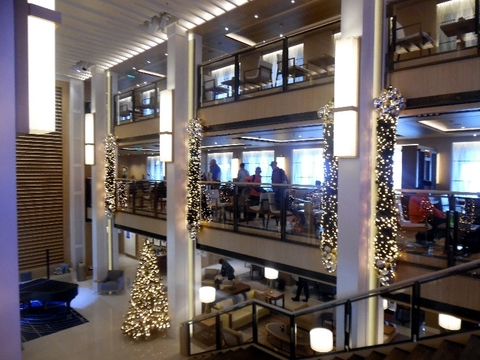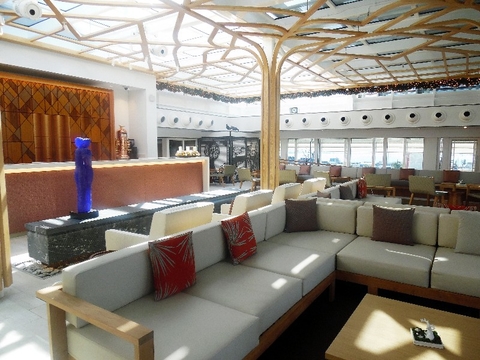The march of Viking Ocean Cruises across the globe continues in a strong way. On Friday, the new 930-passenger Viking Sun sailed from PortMiami on the line's first World Cruise, plus Viking Orion will launch in summer 2018 and an unnamed sister in 2019.
But much more is happening too. On Saturday, European shipbuilder Fincantieri announced that contracts for Viking's seventh and eighth oceangoing ships are now in effect, finalizing a process that began earlier in the year. These two additional vessels will be delivered in 2021 and 2022.
Most notably, though, Viking appears poised to achieve the ultimate fleet vision of Torstein Hagen, its chairman, who has publicly talked about his desire for a 10-ship ocean fleet.
On Saturday, Fincantieri confirmed that Viking had also exercised its option for two additional oceangoing vessels, the fleet's ninth and 10th ships. They're now slated for delivery in 2022 and 2023.
A Ready Source
So where will the ocean passengers come from? One easy answer is "the rivers."
When it comes to the Viking Cruises product, the river passenger and ocean guest are “exactly the same,” said Richard Marnell, the line’s senior vice president of marketing, in talking Friday to Travel Agent and other media touring Viking Sun.
He said there really isn’t a difference in the clientele: “They are absolutely identical.”
In fact, two thirds of the line’s 350,000 ocean passengers who sail each year previously sailed on the line’s river cruise product, Marnell emphasized.
.jpg?itok=KwrAyv_j)
Elsewhere on the ship, guests taking Viking’s first World Cruise (including one greeted above by the ship's captain upon arrival) were settling into deck chairs, finding a corner with a good book or just enjoying drinks with friends they met on past sailings.
For embarkation day, it was an amazingly quiet, smooth experience – doable given the 930-passenger maximum for the new ship, Viking’s fourth. The ship set sail Friday evening for a sold-out, 141-day journey from Miami to London.
Over nearly five months, the voyage will take guests to five continents, 35 countries and 64 ports. The ship will be christened in Shanghai, China on March 8 and the World Cruise will end in London on May 5.
Masterful Growth

The launch of Viking’s first ocean ship, Viking Star, in 2015 was followed by fast paced growth. Today, Viking has four nearly identical, 47,800-grt vessels with 465 staterooms. Plus those other six "sisters" are on the way.
On global rivers, the line – founded 20 years ago to operate Russia voyages – has doubled the size of its market since 2010. Back then, Viking had 26 percent of the market; today that’s 50 percent, Marnell noted.
“Demand continues to be strong in Europe for us,” he stressed, adding that Viking River Cruises is now “leaps and bounds ahead of where we were in 2016.”
Based on North American sourced river cruise passengers, Marnell said the compounded rate of growth between 2004 and 2017 for Viking River Cruises was 18.5 percent, versus 7.7 percent growth for other river lines (not including Viking). That also compares with less than 4 percent for all ocean products.
Today, Viking now operates 64 river vessels in Europe, Asia and North Africa (Egypt). In 2019, the river line will launch seven new vessels on the Rhine, Main and Danube rivers -- Viking Einar, Viking Sigrun, Viking Sigyn, Viking Tir, Viking Ullur and Viking Vali. In addition, Viking Helgrim will launch on the Douro River in Portugal.
Ocean Cruise Marketplace

In terms of oceangoing upscale marketshare, today Viking represents 5.3 percent of the target market of 2.2 million high-spending ocean premium and luxury clients from North America. (Viking Sun's Wintergarden, an interior lounge and relaxation space, is shown above).
Marnell’s numbers show that compares with 33 percent by Princess Cruises, 22 percent by Celebrity Cruises, 18 percent by Holland America Line, 7 percent by Oceania Cruises, 4 percent each by Regent Seven Seas Cruises and Seabourn, 3 percent each by Crystal Cruises and Silversea Cruises and 2 percent by Azamara Club Cruises.
However, by 2021, Viking is expected to have 6.2 percent of that upscale target market, which will rise to 2.7 million North American upscale passengers.
In his presentation, Marnell outlined his perspective about the all-balcony ocean product. He emphasized that the line offers guests spacious, quiet ships with Scandinavian design, an understated elegance, and calming artwork.
Because they’re identical in style and design, “repeat guests begin to feel like they’re home,” he said. They like the familiarity of the ships with the same lay-out.
Value is also important, Marnell said, citing a "no nickel and diming" policy, all balcony accommodations, and included shore trips, port charges and government taxes. Also complimentary are beer and wine with lunch and dinner service, premium dining reservations, Wi-Fi, self-service laundry, access to the Thermal Suite in the LivNordic Spa; and 24-hour room service,
Competitive Insight
On the fare side, he showed a chart providing insight for agents into the line’s competitiveness. It compared fares for cruise products seeking to attract high-end luxury and premium guests.
Marnell said that when comparing northern European itineraries between January and September 2018, the average price per day for the lowest veranda stateroom (includes air and value of included items for each line) is $585 for Viking Sky. That's just above Celebrity Cruises' Celebrity Silhouette at $534.
Everyone else was higher, though at $592 for Pacific Princess, $666 for Azamara Journey, $677 for Crystal Serenity, $700 for Holland America’s Prinsendam, $715 for Oceania’s Marina, $1,020 for Seabourn Ovation and $1,140 for RSSC's Seven Seas Explorer.
So how does the line keep costs down to offer fares that are lower than other competitors. Marnell cited the “cookie cutter” (identical) ship design approach plus energy-efficient features that cut costs on those ships. Also, he said Viking's approach is to not waste space for such elements as an onboard casino or bathtubs in accommodations (except suites).
Viking also benefits, he said, from its existing management/operational structure set up for the river cruise product plus a high level of repeat guests. It also has a highly inclusive product, but also keeps fares lower, he said, by not including two things that are a personal choice, he said, pointing to gratuities and high-end spirits.
Agents, depending on their perspective and clientele, typically will characterize Viking Ocean Cruises as either within the upper premium or luxury space.
As for how the line describes its product, Marnell said the term luxury – while widely used by guests and media --, well, “it’s not something we’ve used in our marketing. It’s not something we would say about ourselves,” noting that “luxury means very different things to different people.”
On a separate note, when asked if Viking will repeat it's million-dollar giveaway contest for agents in 2018, Marnell said nothing had yet been decided/announced, but he wouldn't rule it out either.
One factor is clear. As on the river side, Viking is experiencing fast-paced growth. By 2019, Viking Ocean Cruises will be selling 5,580 beds, versus what's expected for the others: 5,236 beds for Oceania, 2,884 for Silversea, 2,660 for Regent Seven Seas, 2,558 for Seabourn, 2,304 for Crystal and 2,076 for Azamara.
Related Stories
Carnival Corp. Continues TV Push With New Univision Partnership
Stats: 27.2 Million Cruise Passengers to Sail in 2018, Says CLIA